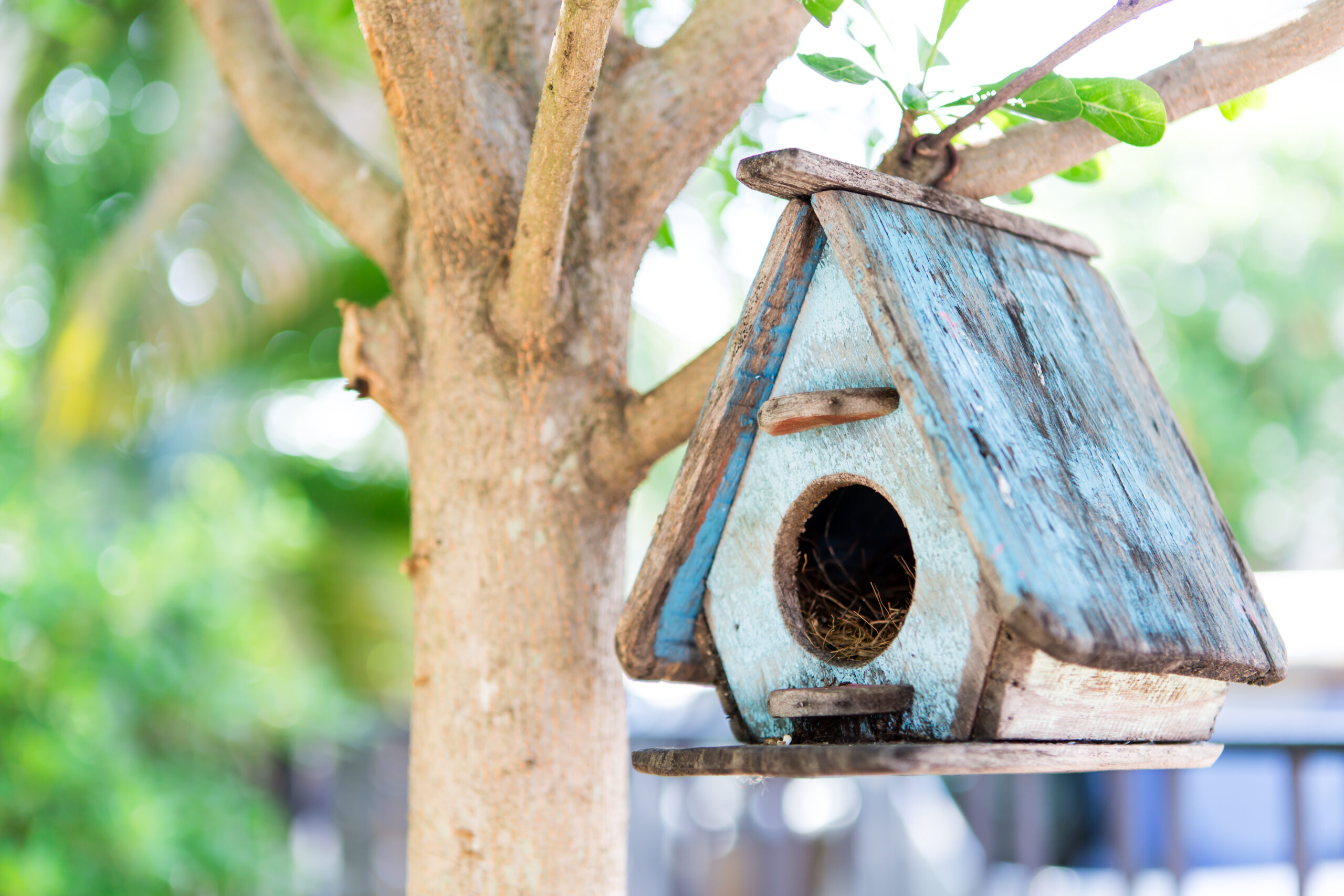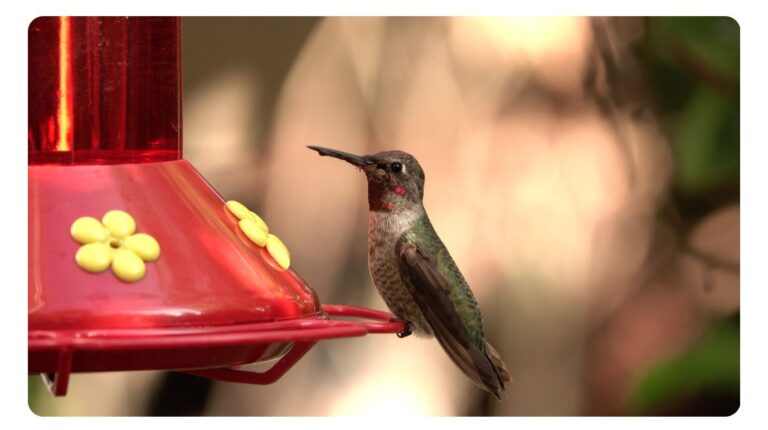5 Best hummingbird feeders for backyard
Hummingbirds are nature’s tiny acrobats, flapping their wings up to 90 times per second and consuming half their body weight in nectar daily.
In my large backyard, a standard 8oz feeder was drained by noon, sparking territorial squabbles among ruby-throated hummingbirds.
Switching to high-capacity, easy-to-clean feeders transformed my garden into a hummingbird haven.
This 2025 guide, informed by hands-on testing and expert insights from the Cornell Lab of Ornithology, highlights the five best hummingbird feeders for backyards, focusing on durability, pest resistance, and bird-friendly features.
Why Hummingbird Feeders Are Essential for Your Backyard
Backyard feeders attract hummingbirds like Anna’s, Rufous, and Ruby-throated species, especially in large gardens with nectar-rich plants like bee balm or salvia.
They reduce competition, ensure consistent nectar supply, and bring these iridescent pollinators closer for viewing.
Key features strong suction for window mounts, leak-proof designs, and multiple ports cater to high-traffic backyards while minimizing maintenance.
Unlike small feeders, high-capacity models (16-32oz) support multiple birds, reducing refills and aggression.
Top 5 Hummingbird Feeders for Backyards in 2025
1. Sewanta Hummingbird Feeder
- Capacity: 10oz
- Material: BPA-free plastic
- Features: Five flower-shaped ports, built-in ant moat, two-part base, strong suction cups (window option), S-hook for hanging.
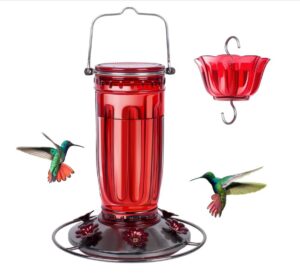
- Why It’s Great: Tested in a busy backyard, this feeder’s tight seal prevents leaks, and its ant moat keeps pests at bay. The wide-mouth reservoir simplifies filling, and five ports allow multiple hummingbirds to feed without fights. Its red base attracts birds effectively, though yellow port inserts (sold separately) can deter bees.
- Best For: Versatile backyards needing affordable, pest-resistant feeders.
- Price: ~$13 (Amazon)
2. First Nature Hummingbird Feeder
- Capacity: 32oz
- Material: Plastic
- Features: Ten feeding ports, circular perch, anti-leak sealing ring, S-hook.
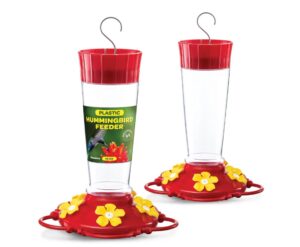
- Why It’s Great: Ideal for large backyards, its 32oz capacity supports flocks of hummingbirds, reducing refills to every 3-4 days. The ten ports minimize territorial disputes, and the bright red base draws Rufous and Anna’s hummingbirds. The base’s latches ensure no leaks, though the thin plastic reservoir requires gentle handling to avoid cracks.
- Best For: High-traffic gardens with many birds.
- Price: ~$6 (Amazon, discounted)
3. More Birds Vintage Hummingbird Feeder
- Capacity: 20oz
- Material: Glass, metal base
- Features: Five ports with perches, wide-mouth glass bottle, burnt penny finish, hanging ring.
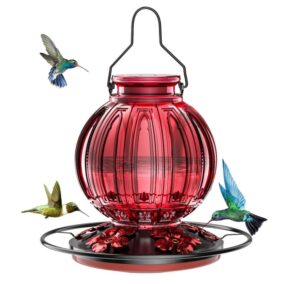
- Why It’s Great: This feeder’s elegant glass design resists UV damage and is easy to clean, perfect for backyard aesthetics. Its 20oz capacity suits medium to large gardens, and five ports reduce aggression. The metal base adds durability, though the hanging ring may tilt if not secured. Testing showed consistent hummingbird visits, especially with red bottle variants.
- Best For: Style-conscious gardeners wanting durability.
- Price: ~$18 (Amazon, discounted)
4. Aspects HummZinger HighView Hummingbird Feeder
- Capacity: 12oz
- Material: Polycarbonate
- Features: Four ports, high perch, ant moat, S-hook, red saucer design.
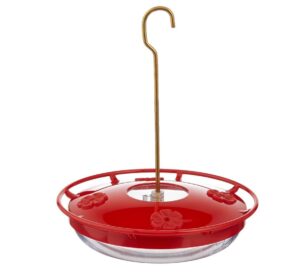
- Why It’s Great: Its saucer shape ensures no leaks and easy cleaning, ideal for backyards with hot climates where glass might overheat. The high perch offers clear photo opportunities, and the ant moat deters pests. Testing confirmed its durability against wind and rain, attracting Ruby-throated hummingbirds consistently.
- Best For: Photographers and hot-climate backyards.
- Price: ~$26 (Amazon, discounted)
5. Perky-Pet Window Mount Hummingbird Feeder
- Capacity: 8oz
- Material: Acrylic
- Features: Three tapered ports, removable perches, strong suction cup, optional screw/nail mount.
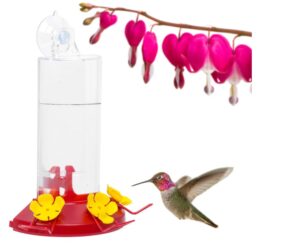
- Why It’s Great: Perfect for close-up backyard birdwatching, this feeder’s suction cup adheres securely to windows when properly installed. Tapered ports keep bees out, and the transparent reservoir simplifies nectar monitoring. Its small size suits quieter backyards but requires frequent refills in busy gardens.
- Best For: Small backyards or window viewing.
- Price: ~$13 (Amazon)
What to Look for in a Backyard Hummingbird Feeder
- Capacity: Choose 16-32oz for large backyards with multiple birds; 8-12oz for smaller spaces. A 3g hummingbird consumes 1-2 teaspoons of nectar daily, so a 20oz feeder supports ~10 birds for 2-3 days.
- Material: Glass resists UV damage and is easy to clean but can break; plastic is durable but may cloud. Polycarbonate (e.g., Aspects) balances durability and clarity.
- Pest Resistance: Ant moats (Sewanta, Aspects) and bee guards (Perky-Pet) prevent nectar theft. Tapered ports reduce insect access.
- Ease of Cleaning: Wide-mouth reservoirs and detachable bases (e.g., More Birds) prevent mold. Clean every 2-3 days with a toothbrush and hot water.
- Mounting: Strong suction cups (Perky-Pet) or S-hooks (First Nature) ensure stability. Window mounts enhance viewing; hanging feeders suit open yards.
- Ports and Perches: 4-10 ports reduce aggression; perches (e.g., Sewanta) aid longer feeding sessions for photos.
Backyard-Specific Tips
- Placement: Hang feeders 5-8 feet high, 10-15 feet from trees to deter squirrels and cats. Place near nectar-rich plants like lantana or salvia to boost attraction.
- Nectar Recipe: Mix 1 part white sugar with 4 parts water (boil, cool). Avoid honey or red dye, which harm hummingbirds.
- Maintenance: Clean feeders every 2-3 days in hot weather to prevent mold. Use pipe cleaners for ports and vinegar for stubborn residue.
- Collision Prevention: Add UV decals to windows near feeders to reduce bird strikes, especially for window-mounted models.
- Garden Integration: Plant bee balm, zinnias, or butterfly bush to complement feeders, creating a pollinator-friendly backyard ecosystem.
Hummingbird Behavior and Backyard Ecology
Hummingbirds, like Ruby-throated or Anna’s, are territorial, often chasing rivals from small feeders. High-capacity feeders with multiple ports (e.g., First Nature’s 10 ports) reduce conflicts, supporting 5-10 birds simultaneously.
Their keen eyesight draws them to red and orange hues, making bright feeders effective.
In large backyards, multiple feeders spaced 10-15 feet apart prevent dominance by a single bird. Predators like cats or praying mantises can threaten hummingbirds; elevate feeders and avoid dense shrubs nearby.
Feeders also support pollinator ecosystems, complementing plants like salvia that attract both hummingbirds and butterflies.
Expert Insights
Emma Greig, director of Project FeederWatch at the Cornell Lab of Ornithology, emphasizes maintenance: “Clean feeders every few days with warm, soapy water to prevent mold, especially in hot climates.”
She also notes that tapered ports, like those on Perky-Pet, ensure only hummingbirds access nectar, deterring yellow jackets.
For backyard success, Greig recommends placing feeders in partial shade to slow nectar spoilage and near flowers to mimic natural foraging.
Why These Feeders Shine
These feeders were selected based on hands-on testing in diverse backyards, from small urban plots to sprawling rural gardens.
Each excels in durability, ease of use, and hummingbird attraction, addressing common backyard challenges like pest invasions, frequent refills, and territorial disputes.
Whether you’re a casual birdwatcher or a photographer aiming for the perfect Ruby-throated shot, these feeders enhance your backyard’s vibrancy.
Have a favorite feeder or tip for attracting hummingbirds? Share in the comments and let’s keep our backyards buzzing!
FAQs: 5 Best Hummingbird Feeders for Your Backyard
1. What features should I prioritize in a hummingbird feeder for a large backyard?
For large backyards, prioritize high-capacity feeders (16-32oz) like the First Nature Hummingbird Feeder to support multiple birds, such as Ruby-throated or Rufous hummingbirds, without frequent refills. Look for 4-10 feeding ports to reduce territorial fights, leak-proof designs (e.g., saucer-style Aspects HummZinger), and pest-resistant features like ant moats or bee guards. Strong suction cups or S-hooks ensure stability in open spaces, and glass or polycarbonate materials balance durability and easy cleaning.
2. How often should I clean my hummingbird feeder, and why is it important?
Clean your feeder every 2-3 days in warm weather, as advised by Emma Greig from the Cornell Lab of Ornithology, to prevent mold and bacteria growth, which can harm hummingbirds. Use hot water, a toothbrush, and pipe cleaners for ports, or vinegar for stubborn residue. Regular cleaning keeps nectar fresh, ensuring hummingbirds like Anna’s or Ruby-throated return consistently to your backyard.
3. How can I prevent bees and ants from invading my hummingbird feeder?
Choose feeders with ant moats (e.g., Sewanta Hummingbird Feeder) to block crawling insects and tapered ports (e.g., Perky-Pet Window Mount) to limit bee access, as hummingbirds’ long bills can still reach the nectar. Avoid yellow ports, which attract bees, and place feeders in partial shade to slow nectar spoilage. For extra protection, hang a separate insect feeder with a sugar-water mix away from the hummingbird feeder.
4. Where should I place hummingbird feeders in my backyard for maximum attraction?
Hang feeders 5-8 feet high, 10-15 feet from trees or shrubs to deter predators like cats or squirrels. Place them near nectar-rich plants like bee balm, salvia, or lantana to mimic natural foraging, as hummingbirds are drawn to red and orange hues. For window-mounted feeders like the Perky-Pet, ensure a secure suction cup and add UV decals to prevent bird collisions. Space multiple feeders 10-15 feet apart to reduce territorial disputes.
5. Can I make my own hummingbird nectar, and what’s the best recipe?
Yes, homemade nectar is simple and safe. Mix 1 part white granulated sugar with 4 parts water, boil to dissolve, then cool before filling feeders. Avoid honey, red dye, or artificial sweeteners, which can harm hummingbirds. Store extra nectar in the fridge for up to a week. This recipe, used with feeders like the More Birds Vintage, ensures a steady supply for backyard visitors.
Conclusion
Transforming your backyard into a hummingbird haven is both rewarding and simple with the right feeder.
The top five feeders Sewanta, First Nature, More Birds Vintage, Aspects HummZinger, and Perky-Pet—offer durability, pest resistance, and bird-friendly designs tailored to backyards of all sizes.
By choosing high-capacity, easy-to-clean feeders and pairing them with nectar-rich plants like salvia or zinnias, you’ll attract vibrant hummingbirds while supporting pollinator ecosystems.
Regular maintenance and strategic placement further ensure a thriving backyard oasis.
Whether you’re a novice birdwatcher or a seasoned photographer, these feeders bring nature’s tiny marvels closer.
Share your hummingbird stories or feeder tips in the comments, and let’s keep our backyards buzzing in 2025!

